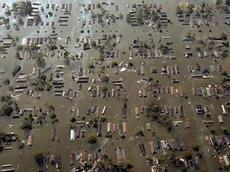The state of knowledge on climate change
Two scientists provide a summary of the state of research on the subject of climate change in the on-line edition of Nature Geoscience. It could form a basis to enable decision-makers to choose the most appropriate course – the purely economic alternative or the scientific and socially compatible one.

An idea that has existed for many years was confirmed again with the publication last year of the Fourth Report by the Intergovernmental Panel on Climate Change (IPCC): the emission of carbon dioxide caused by humans is mainly responsible for global warming. Almost all scientists taking part in the writing of the report agree on this point. However, opinions differ about the magnitude of future variations and how climate change should be dealt with. In their summary of research results extending back to the start of climate observation, Professor Reto Knutti at the Institute for Atmospheric and Climate Science of ETH Zurich and Gabriele Hegerl at the School of Geosciences of the University of Edinburgh provide an objective basis for discussion.
Determining climate sensitivity
Reto Knutti says one must know essentially two parameters in order to estimate long-term climate change. Firstly, one must know how much of the CO2 emitted by humans remains in the atmosphere and what proportion is absorbed by the oceans and the biosphere. Secondly, one must know the effects of CO2 on the climate system, the so-called climate sensitivity. “This describes the global warming at equilibrium if the atmospheric CO2 is doubled.” The parameter is a measure of how strongly the climate responds to CO2, and corresponds to the climate’s expected temperature rise. The bigger the number, the greater the climatic effects.
Major uncertainty in the maximum values
The researchers obtain estimates of this unknown parameter through climate models and by studying short-term events during which the climate changed. For example the climate’s sensitivity is estimated based on CO2 data and the temperature variations of the last ice ages or the cooling following the volcanic eruption of Mount Pinatubo. However, the processes in an ice age or in a volcanic eruption are different to those of today’s climate warming, therefore the results cannot simply be transferred. Based on climate models it is known that the warming would amount to about one degree Celsius if only the CO2 content doubled and there were no feedback loops caused for example by water vapour, clouds or increased absorption of radiation by the earth. However, the models suffer from large uncertainties if feedback effects are taken into account. Climate researchers currently assume that the temperature increase caused by CO2 emissions including the feedback effects will be three times as large, i.e. an increase of about three degrees Celsius. The range of uncertainty is between 2 and 4.5 degrees Celsius. However, there is a large uncertainty with regard to the maximum value: the models and calculations show that the possibility of the earth warming up by 8 to 10 degrees Celsius cannot be excluded. Knutti says that although the likelihood of this is relatively small, the consequences would be catastrophic.
It is surprising that at the end of the 19th century the first estimates of warming in the event of a doubling of CO2 emissions were already in the same range as today’s predictions. Knutti says that although much detailed knowledge was gained in the past ten years, the overall picture has not changed significantly. The question that arises with the present knowledge is what would be a “tolerable” CO2 increase. Knutti says “The EU postulated that a temperature rise of two degrees Celsius compared to the pre-industrial era would be acceptable.” That would mean that the CO2 level could be allowed to increase worldwide to a maximum of 450 parts per million (ppm), but it is already about 380 ppm today. The global emission of CO2 would need to be at least halved by the middle of the century in order not to exceed the 450 ppm level. Knutti says “However, the problem is that the economic growth of developing countries such as India and China would be retarded as a consequence.”
Possible courses of action
Knutti: “Our summary shows that although the studies published during the past ten years have provided many fascinating new insights into our climate system, they have brought little additional certainty as to the expected maximum long-term warming. However, the summary might provide decision-makers with a basis for further measures.” For example whether preference should be given to standard economic ideas such as discounting. This involves saving the money that would instead have been spent on reducing emissions and on damage prevention, allowing it to grow, and then investing it only if at the end of the century a catastrophy really occurs – which would then, according to this theory, be relatively cheap to manage as a result of the growth in the funds. The economist Sir Nicholas Stern decisively opposed such ideas in his Report of October 2006. In his opinion, the consequences of a climate catastrophe such as water shortage or flooding of land inhabited by millions of people cannot be solved with money, and action must be taken now.
The analysis by Knutti and Hegerl shows that the
short-term trends and the minimum expected amount of warming if the CO2
concentration doubles could be determined with a small uncertainty. The
remaining major uncertainties in the maximum range should motivate
decision-makers to take active steps – even if some people, as a result of the
prevailing financial crisis, have already asked for cheaper options to mitigate
climate change.
Literature reference:
Knutti R & Hegerl G: The equilibrium sensitivity of the Earth’s temperature to radiation changes, Nature Geosciences, 1, 735-743, doi:10.1038/ngeo337, www.nature.com/naturegeoscience, Published online: 26 October 2008







READER COMMENTS